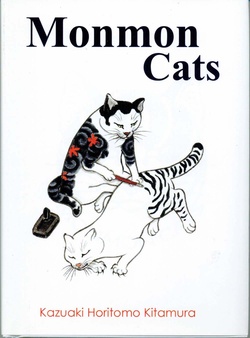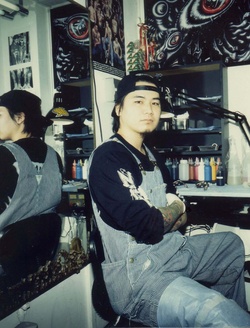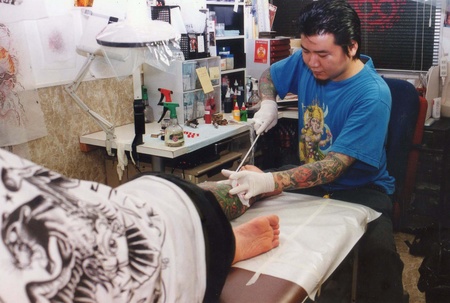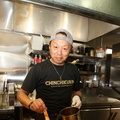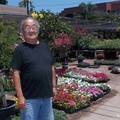I have a book here. It’s an English book titled Monmon Cats. Readers can find pictures of cats tattooed with a variety of Japanese designs throughout the 118 pages of this book. The writer is a tattoo artist by the name of Horitomo, originally from Mie Prefecture, Japan, who now works in San Jose, California. For those who don’t know that the word “Monmon” is another name for tattoo, perhaps the book title would sound completely unfamiliar. However, in this book we can find the deep beliefs of Horitomo as a tattooist. It was published by his current workplace, a tattoo studio called State of Grace, in 2013, six years after Horitomo moved to America. How did Horitomo write and publish this book? In its process, we can find his lifelong “wish” and “dream.”
“Tattoos and Cats”
In the preface, Horitomo explains how cats have been treated by humans since the beginning of history. For a long time, in both Eastern and Western parts of the world, cats have been alienated by humans, as they were removed from the twelve signs of the Chinese zodiac and characterized as cat ghosts or in company with witches. They seem to be disliked in Buddhism, too, as we can rarely find cats in Shaka-nehanzu among many other animals. On the other hand, in contemporary history, they are cherished as the symbol of “good luck” as in beckoning cats and as animals that protect crops and silkworms from rats. Horitomo reflects how tattoos have been dealt in society onto how people have treated cats.
“There seem to be similarities between the conflicting feelings that people have toward cats and how they feel about tattoos in Japanese society. Because of this, cats and tattoos are a great match for me.”
Horitomo says that as a tattooist he was greatly inspired by the drawings of cats by Kuniyoshi Utagawa, an ukiyoe artist who flourished from the end of the Edo period to the Meiji era, but it’s been many years since he first became strongly interested in the traditional tattoos in Japan and their design. It goes back to when he was working in Japan.
Discovering Tattoos
His first encounter with tattoos goes back nearly 25 years ago. He was working to become a chef at the time, but then realized that it was not for him, as he learned more and more about the industry. So he quit. Without having any clear ideas about what to do next, he worked part-time and spent his free time surfing. Some of his fellow surfers had tattoos, yet at first they didn’t strike him much. He just thought they looked “cool.” But gradually he began to want tattoos on his own body—those of Western style. So he looked for a tattooist in his hometown, in Mie Prefecture, yet such “Western-style” tattooists were rarely found in those days.
It was just at this time when a friend of his told Horitomo about a tattooist in Nagoya who had returned from Brazil. Originally he had an engineering-related job in Japan, but he quit the job and moved to America. After moving around Central America, he went to South America and studied tattoos in Brazil. He had long hair and was wearing hippie-like tie-dyed pants. He looks like a fun guy to be with. This was Horitomo’s first impression of him.
Horitomo went to his studio in Nagoya to get tattoos. There he saw a collection of tattoo magazines from America. He still remembers the excitement that he had, when he first saw them.
His First Tattoo
Horitomo says that he didn’t have any hesitation. “I was young, and at the time I was “living in the moment.” I wasn’t thinking about having a long, healthy life ahead.”
He wasn’t sure how he wanted to live, so he had no real plans for work.
However, one incident changed his mind. It was an accident during surfing. He went surfing in the sea when there were big waves forming under a storm. And he got badly injured.
“I’ve been afraid of big waves ever since. I realized that I was just pretending to be strong. So the accident made me think about my future more seriously and change my living-in-the-moment lifestyle.”
Having realized that he had to change his life, he began to think about his job and future. Then he found a road to becoming a tattooist.
Working Toward Becoming a Tattooist
Horitomo’s career as a tattooist began as an apprentice at a street tattoo shop in Nagoya, the first of its kind in Japan, which was opened by the tattooist mentioned before, who had returned from Brazil. It was back in 1993.
Of course, he had some anxiety. But his desire for becoming a tattooist was stronger, which made him keep going. At first he didn’t tell his parents about the work, but his father seemed to have an inkling as to what his son was getting into. Being a stubborn carpenter as he was, he had worked with tattooed artisans before, so he didn’t object to Horitomo when he made the confession, about two years later. He told his son that it was his life. “My mother cried and wanted me to change my mind. Even to this day, I don’t think she approves of my work 100%,” Horitomo says.
Four years later in 1997, he moved to Tokyo and worked in two studios: one in the Takeshita Street, Harajyuku, and the other in Nakameguro, owned by his friend tattooist. In the following year, 1998, he moved to Osaka, took part in opening a new studio, and worked as a lead tattooist.
At the same time, since 1994, Horitomo had visited a number of tattoo conventions overseas. He’s been to such conventions in San Diego, Philadelphia, and Seattle in America, and in the Netherlands. Back in those days, the tattoo boom was already there in America and Europe, with conventions as big as ones we see today taking place. In 1996, he worked as a guest tattooist in a tattoo shop in San Francisco, which was known as the “sanctuary” of tattoos at the time. And in 1999, he participated in a convention in Spain. As such, he had chances to learn about tattoos in other countries.
Meeting Ryudaibori for the First Time
As mentioned before, Horitomo changed his workplaces from Nagoya to Tokyo and to Osaka. He says that each shop had its own characteristics. “The experience I had at each place is so deep that it would take hours to talk about them.” In those days, he was learning Western-style tattoos, which was rarely seen in Japan at the time, and Horitomo learned and absorbed many different techniques. However, he wouldn’t be where he is now, without his encounter with Ryudaibori (his old name: Horitaka), the owner of Horitomo’s current workplace, as mentioned earlier, a tattoo studio called State of Grace in San Jose. But the story is yet to come.
It was in 1997 when Horitomo met Ryudaibori for the first time, who had come to Japan from America to get his training. In fact, Ryudaibori had come to the studio in Harajyuku where Horitomo was working at the time, but their relationship didn’t develop any further.
In 2001, Horitomo moved from Osaka to Yokohama, to seriously start learning about traditional tattoos in Japan, and he began to learn under some active tattooists there. Ryudaibori was also learning there. Thus began their relationship as fellow pupils. Plus, the fact that their last names are both “Kitamura” seemed like some kind of fate.
When Horitomo was training in Nagoya, he didn’t have much interest in traditional Japanese tattoos. But he became more and more drawn to them as he built his career as a tattooist. He had already started learning on his own about tattoos in Japan when he moved his residence from Tokyo to Osaka, but he moved to Yokohama for more serious learning. He had started his training on traditional Japanese hand tattooing in Osaka, which turned into a much more serious project after he moved to Yokohama.
Also, he had already planned on going to America when he was still in Nagoya. He was learning about Western-styled tattoos in Nagoya, and was struck by the sight of tattoos at Western conventions. Then he came to think that it would be best to work in America if he were to learn about Western styles. It was in 1995 and 1996. But the problem was that he didn’t have a visa. He did a lot of research, but there was no such visa that Horitomo could get, as he didn’t have extensive career as a tattooist, on top of his academic background.
So he gave up on moving to America and left Nagoya for Tokyo to gain more experience in Japan. And he moved his workplaces from Tokyo to Osaka and to Yokohama, as he developed his interest in Japanese traditional tattooing, as mentioned before.
© 2015 Yukikazu Nagashima


